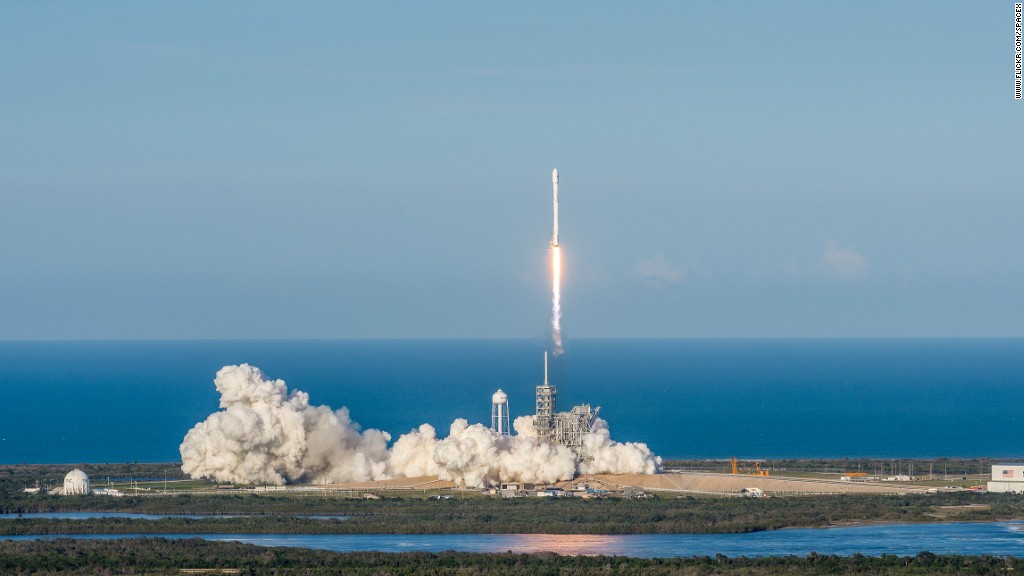
SpaceX was forced to delay an historic launch that was slated to send a used spacecraft into orbit.
The pioneering company, headed by Tesla (TSLA) CEO Elon Musk, wants to try to reuse a Dragon spacecraft on an unmanned resupply trip to the International Space Station.
But Musk said on Twitter that Thursday's launch attempt was scrubbed due to lightning. SpaceX will try again on Saturday at 5:07 pm ET at the Kennedy Space Center in Cape Canaveral, Florida.
SpaceX has proven it can reuse a first-stage rocket booster, which flings the spacecraft toward orbit. But it hasn't ever attempted to reuse the craft that actually goes into orbit.
The Dragon ship sits at the very top of SpaceX's Falcon 9 rocket and is designed to carry cargo to orbiting space stations.
SpaceX has completed 10 resupply missions to the ISS since 2012, and it's used a Dragon each time.
Reusing a spacecraft isn't new. The NASA space shuttles, for example, made multiple trips to orbit.
But the endeavor is a landmark for the growing commercial space industry. Traditionally, space travel has been the work of governments, because corporations have been averse to the daunting risks involved in space travel. But over the past decade-plus, SpaceX -- and a few other competing private space companies like Blue Origin, United Launch Alliance and Orbital ATK -- have upended that notion.
Related: SpaceX launches used rocket and then lands it
If the mission goes as planned, the Dragon will be captured by a robotic arm as it flies by the space station in order to dock with it. Then, the space station crew can bring the supplies on board.
On this trip, the Dragon will deliver nearly 6,000 pounds of supplies -- everything from food for the crew to fruit flies and rodents that will be used in various experiments.
The space station currently has five astronauts on board: two from the United States, two from Russia and one European Space Agency astronaut from France.
The Dragon will stay docked for about a month, and it will be loaded with lab results and garbage before it heads home. The Dragon will then make a splash landing in the ocean, where it can be recovered by SpaceX.
Reusing a spacecraft will mark another huge step forward in SpaceX's efforts to bring down the cost of spaceflight.
In March, SpaceX became the first company to launch, land and then reuse the first stage of an orbital-class rocket. Musk also said the company recovered at least a portion of the rocket's fairing -- a rocket add-on that can house satellites -- after that launch.
Related: SpaceX's playbook -- make history, then make more history

The first-stage booster is the most expensive piece of the rocket, according to Musk, accounting for up to 60% of the rocket's $62 million sticker price.
SpaceX does not publicly say how much the Dragon spacecraft is worth. But considering NASA pays SpaceX about $133 million for each mission, and that price would include the cost of the rocket and the Dragon, the spacecraft is likely worth tens of millions of dollars.
It's not clear how much SpaceX had to spend to refurbish the Dragon. But the company will undoubtedly save a significant chunk of cash by reusing it.
SpaceX's Hans Koenigsmann said at a press conference Wednesday that the company is looking to make back some of the money it has poured into technology development.
"We've invested a significant amount of money that we need to recover," Koenigsmann said.
Related: Branson! Musk! Bezos! The billionaire space race throwdown
The CRS-11 mission Thursday will not use a pre-flown rocket. NASA tends to be extra cautious about taking on added risks, though NASA ISS program manager Kirk Shireman said NASA is "working on" approving flights with used rockets.
The next SpaceX launch with a used rocket will be a June 15 mission for BulgariaSat.

